Close Encounters of the Cuttlefish Kind
At Wakatobi, encounters with glowing, other-worldly creatures like cuttlefish happen every day
With eight arms growing out of their heads, and three hearts pumping blue blood through their pliable, gelatinous bodies, cuttlefish may seem like creatures from another planet, but they actually thrive in abundant numbers on the colorful reefs of Wakatobi.

Hovering low to the bottom, a large broadclub cuttlefish (Sepia latimanus) evades the detection of a passing underwater photographer.
They could be lurking close by, blending in perfectly with the coral reef or a seagrass bed. But unless a cuttlefish chooses to reveal itself, you could swim right by this alien-like creature without even knowing it was there. Sometimes referred to as “the chameleon of the sea,” cuttlefish have a remarkable ability to rapidly alter their skin color and patterning at will–sometimes seeming to disappear among their surroundings, then suddenly exploding in a pulsating display of moving light that can hypnotize prey or signal to others of their kind.
Like other cephalopods such as octopus and squid, cuttlefish have specialized pigment cells in their skin called chromatophores. These cells are infused with multi-colored pigment particles that are activated by the nervous system or by hormonal signals. Their skin also contains a second type of cell known as iridophores, which reflect and refract light in ways that result in silvery or iridescent colors, and make the cuttlefish’s skin appear to flash luminous, much like a strobe light.

Cuttlefish skin contains a type of cell known as iridophores, which reflect and refract light, making the skin appear to flash luminous, like a strobe light.
The same chameleon-like abilities that allow cuttlefish to control their color and skin texture and blend with the reef or sea bottom, also provide them with a means of communication, whether to attract a mate, warn off rival cuttlefish or even stage a performance to confuse their prey. At their most spectacular, cuttlefish may cycle through color and pattern changes so rapidly that their skin will actually pulse, as if they are sending electrically charged waves of light and dark through their bodies, adjusting the rhythm from slow to fast to slow again.
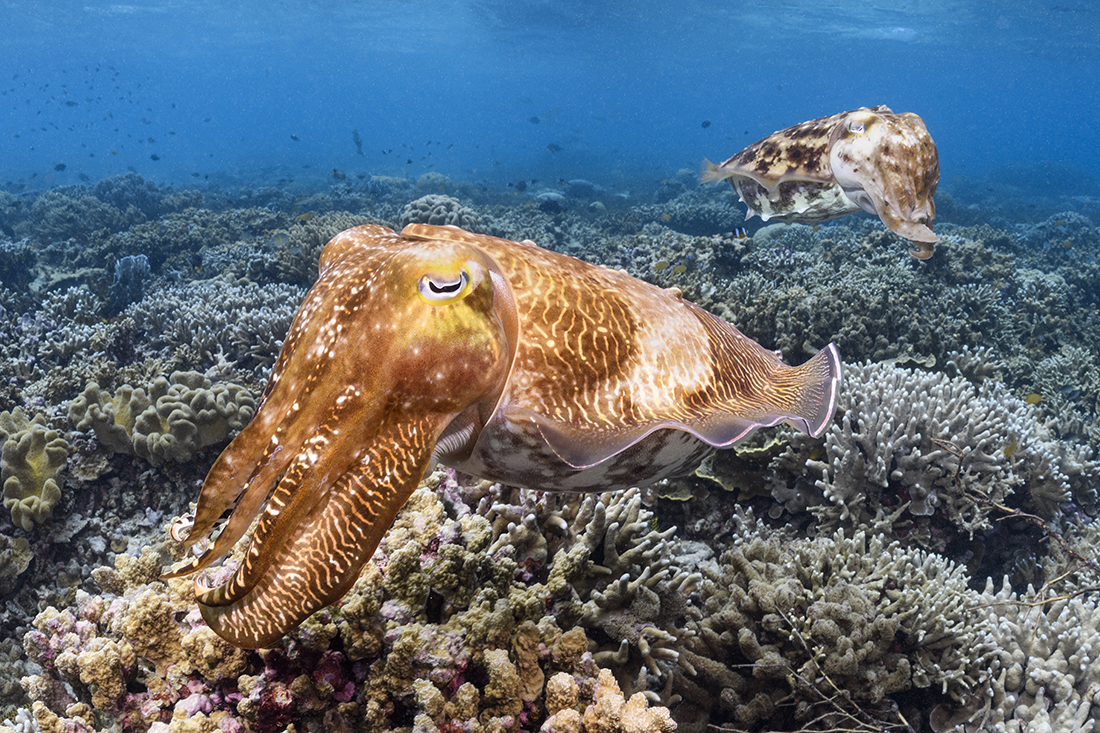
During courtship, the larger male cuttlefish will follow the female, eventually grabbing her with his tentacles in an attempt to turn her so they are face-to-face. Photo by Walt Stearns
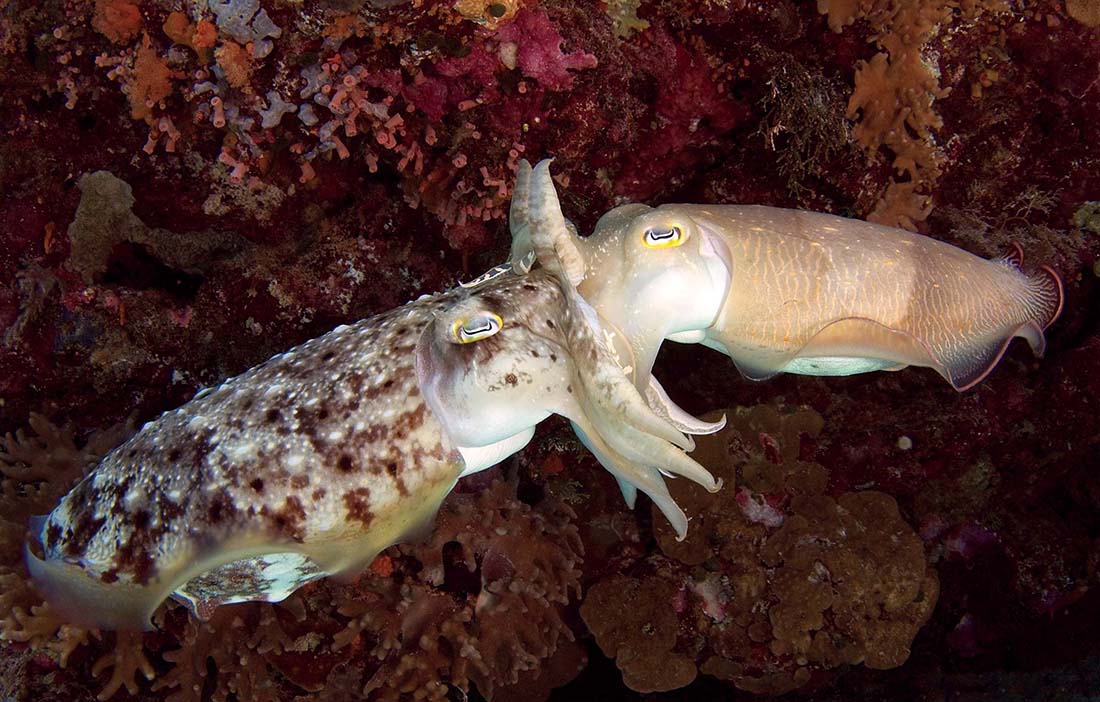
To mate, the male will insert sperm sacs into an opening near the female’s mouth. Photo by Mark Synder
Male cuttlefish challenge one another for dominance and the best den throughout mating season. During this challenge, no direct contact is made. The animals threaten each other until one of them backs down and swims away. Eventually, the larger male cuttlefish mate with the females by grabbing them with their tentacles, turning the female so that the two animals are face-to-face, then using a specialized tentacle to insert sperm sacs into an opening near the female’s mouth. The male then guards the female until she lays the eggs a few hours later.
On occasion, a large competitor arrives to threaten the male cuttlefish. In these instances, the male will first attempt to intimidate the other fish. If the competitor does not flee, the male will eventually attack it to force it away, and the confrontation turns physical. The cuttlefish that can paralyze the other first by forcing it near its mouth would win the fight, and the female. Since there are, on average, four or five (and sometimes as many as ten) males for every female, this kind of behavior is inevitable.
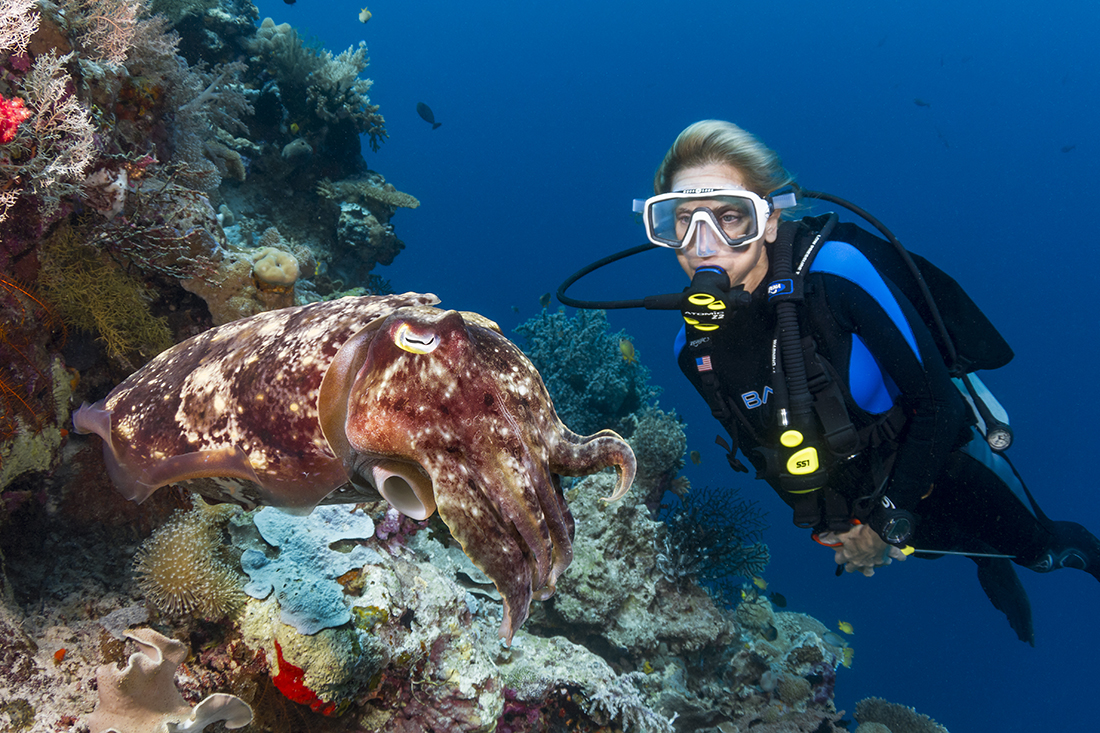
Face to face with a large broadclub cuttlefish (Sepia latimanus) at Cornucopia. To express that you are not a threat, approach the cuttlefish slowly without making any sudden or aggressive movements.
At Wakatobi, there’s a chance of finding cuttlefish on nearly any dive. Their range extends from the shallow grass beds to deep reefs, and everything in between. When cuttlefish are in camouflage mode, it will take a very sharp eye to spot them, as they can blend almost perfectly into their surroundings. On the other hand, if they choose to reveal themselves, they are hard to miss, as they will often rise up from the bottom and start flashing bright color patterns. It’s as if the switch was flipped on a battery-powered strobe light.
By revealing themselves, cuttlefish are indicating that you are not a potential threat.
When you see a cuttlefish, look around, because it’s probably not alone. While juveniles are more likely to remain solitary, adult cuttlefish usually travel in groups of two or more, and it’s not unusual to find a half dozen moving in loose formation. By revealing themselves, cuttlefish have decided that you are not a potential threat. If you wish to approach for a closer look, you will need to maintain that non-threatening impression by moving slowly and patiently, without making any sudden or aggressive movements. Sometimes, it is the cuttlefish themselves who will move closer, as they seem to be naturally curious when not threatened.
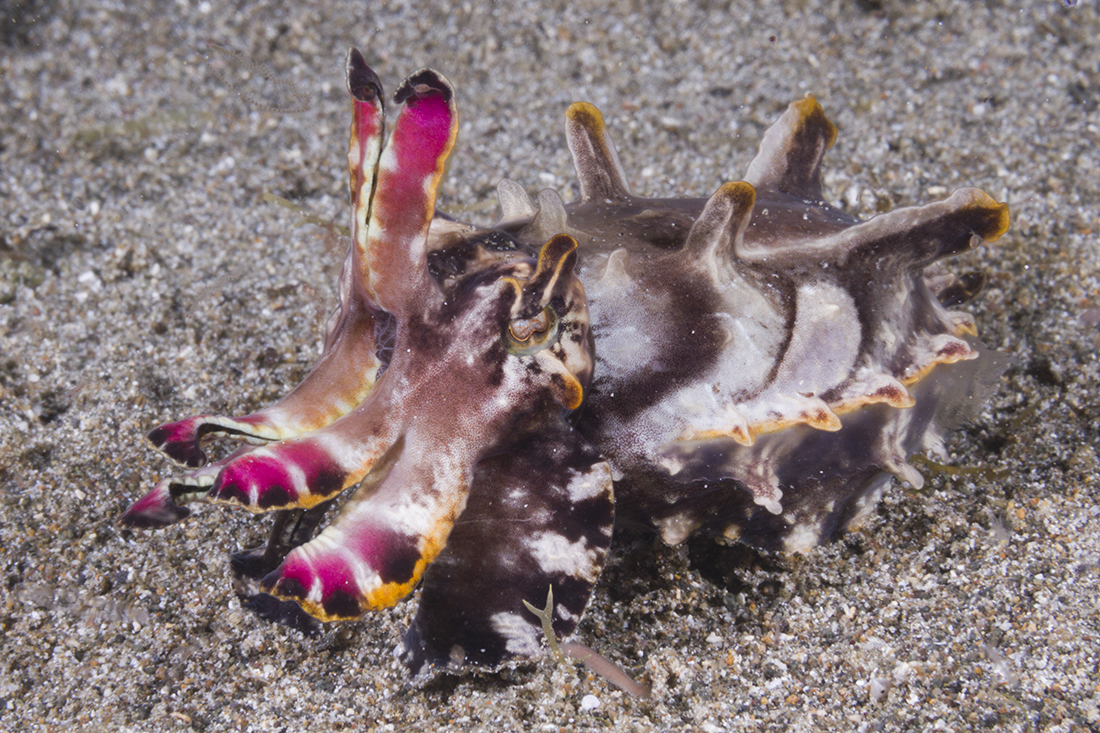
The Flamboyant cuttlefish doesn’t swim and hover midwater like other cuttlefish. Instead, it crawls on the seafloor like an octopus.
The cuttlefish you are most likely to see around Wakatobi is the broadclub (Sepia latimanus), which can reach lengths of more than a foot. Guests who take a cruise on the Pelagian also stand a good chance of seeing the aptly-named flamboyant cuttlefish (Metasepia pfefferi) during night dives. This species is nocturnal, spending their days buried in the type of soft sea floor sediment found on muck diving sites around Buton Island, and emerging only under cover of darkness. Because of its extra-small cuttlebone, the Flamboyant has a hard time with buoyancy. It can’t swim for very long without sinking to the bottom. But what it lacks in buoyancy, it makes up in flambuoyancy!
Fortunately, cuttlefish are not yet considered to be threatened or endangered, and they do especially well in protected areas such as Wakatobi’s marine preserve.
Though they are among the cleverest and most elusive creatures in the sea, cuttlefish are not immune to human impacts. In many parts of the world, cuttlefish are fished for food, and also to harvest the internal shell known as a cuttlebone, which is used in the pet trade to provide caged birds with a calcium-rich pecking supplement. Fortunately, cuttlefish are not yet considered to be threatened or endangered, and they do especially well in protected areas such as Wakatobi’s marine preserve.
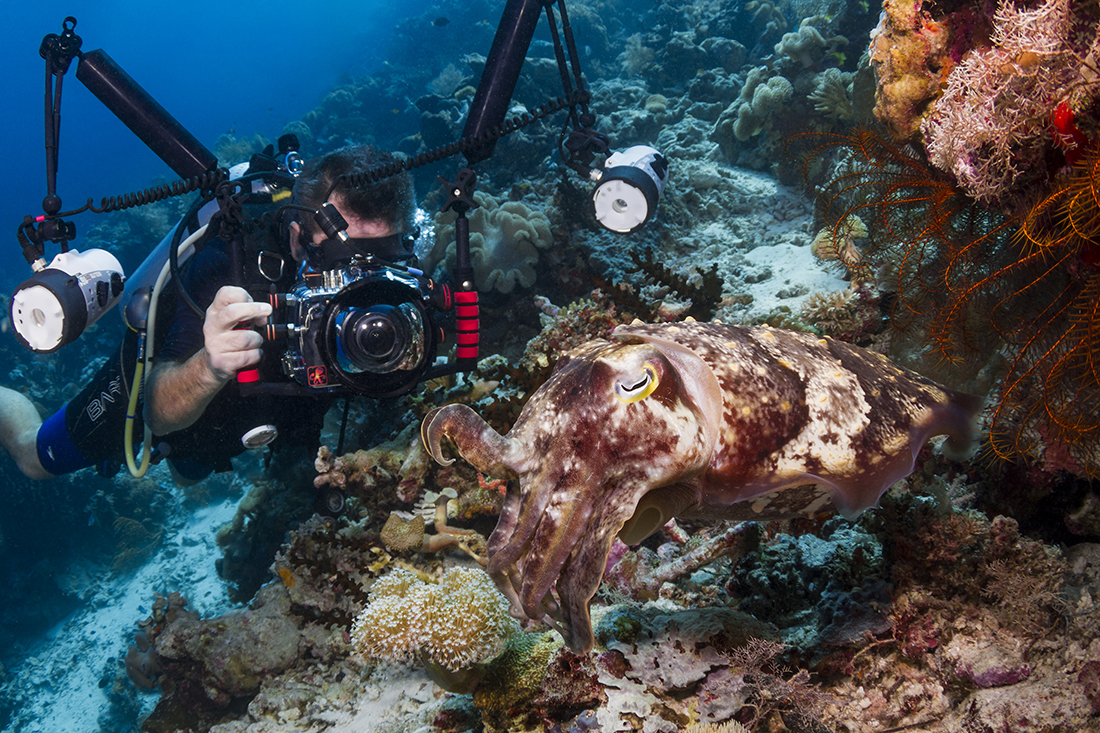
Cuttlefish make excellent photographic subjects, in that because they are not only cooperative in most instances, but they can also be particularly entertaining through their change in coloration from one shot to the next.
When visiting Wakatobi, be ready for a cuttlefish encounter, as you never know when these sleek, iridescent hunters will reveal themselves. And if you can imagine that cuttlefish are extraterrestrials who came to earth, then hovering weightless as you watch one of these strange creatures pulsate in other-worldly color patterns might well be as close as you can ever come to visiting another planet.
Ready for some amazing marine life encounters? Complete a quick trip inquiry at wakatobi.com, contact our office at office@wakatobi.com.
Visit us on Facebook.



